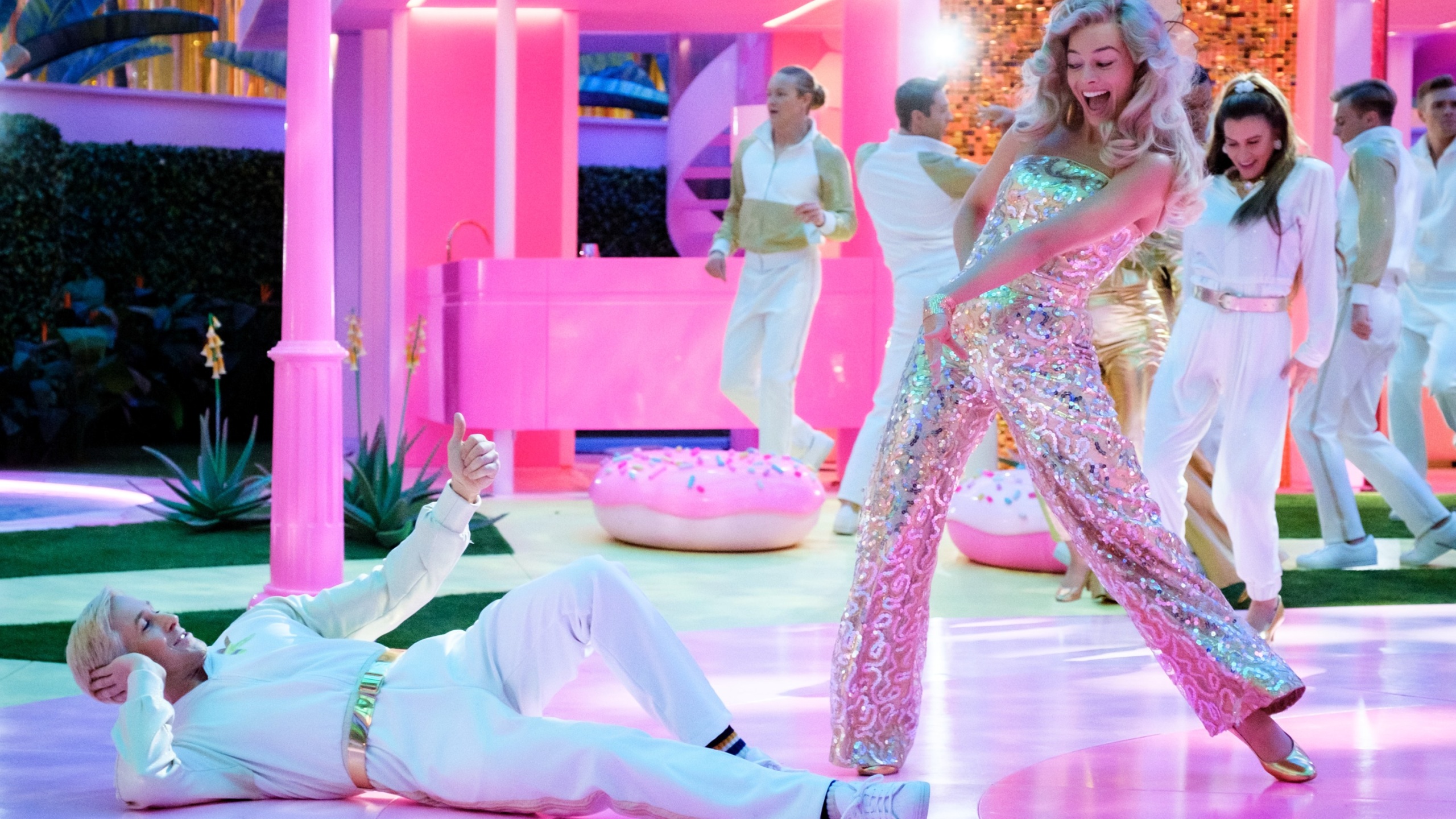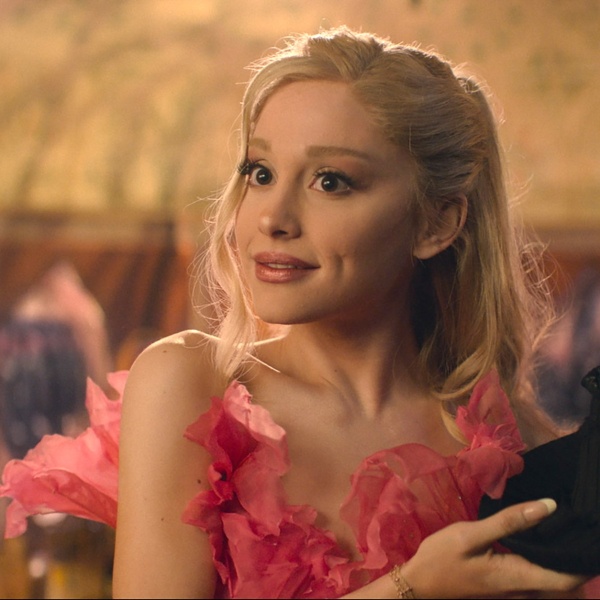
It opens, of course, with an homage to Stanley Kubrick’s “2001: A Space Odyssey.” A dazzling sunrise stretches over a barren desert, populated exclusively with sad-eyed Dust Bowl-era girls and their unblinking baby dolls, as Helen Mirren (!!) narrates us through what life was like pre-Barbie. It wasn’t just boring (though it was certainly boring), but it was limited (oh, was it limited). For so many little girls, dolls were only ever baby dolls, which meant that their playtime could only ever revolve around motherhood, servitude, and no fun whatsoever.
But just as Kubrick’s apes eventually met by an alien monolith that utterly changed their world and worldview, Greta Gerwig‘s little girls are about to be descended upon by a world-altering and brain-breaking new entity: a giant, one might even say monolithic, Barbie doll, in the form of a smiling Margot Robbie, kitted out like the very first Barbie doll ever made. And thus spake Barbie. That’s where Gerwig’s funny, feminist, and wildly original “Barbie” begins. It will only get bigger, weirder, smarter, and better from there.
Imagine, if you can, a world split in two upon the release of the first Barbie doll in 1959. There’s the real world (known in the film as, of course, “The Real World”), and then there’s the seemingly idyllic (and very plastic) Barbie Land, which exists on the premise that the invention of Barbie (the doll) so drastically, so completely, and so positively impacted the real world that she (the doll) basically solved feminism. As far as the Barbies (and attendant Kens) who populate Barbie Land know, the Real World is a wonderful place for women (because Barbie Land very much is), and the female-forward world they happily clatter through is just a reflection of what happens in the flesh-and-blood universe.

In Barbie Land, it’s the women who rule (Issa Rae is President Barbie, Alexandra Shipp is Writer Barbie, Emmy Mackey is Physicist Barbie, the list goes on and on). Oh, the Kens? Yeah, yeah, they’re there, too. But it’s called Barbie Land for a reason. And while all Barbies are equally talented, fulfilled, happy, and free (every night is girls’ night!), for the purpose of Gerwig’s “Barbie,” our attention lands on one who is about to go on a very unexpected journey: Stereotypical Barbie (Robbie).
ThisBarbie (like, it seems, all Barbies) has a great day every day. Her Stereotypical Ken (a delightfully unhinged Ryan Gosling)? He only has a good day when Barbie pays attention to him, and Barbie is pretty busy. Gerwig guides us through a typical Barbie day with meticulous attention to detail (both impressive and incredibly amusing). Her Barbie Dream House? It doesn’t have windows, or working stairs, or running water. She can get wherever she wants to go by simply jumping (just like a child might move their doll, foisting them from spot to spot with little care for logic). Her hands are stiff. Her food is nonexistent. Her life is perfect. Robbie’s dedication to the gag, along with co-stars Rae, Shipp, Mackey, Hari Nef, and Nicola Coughlan is profound, and boy, does it pay off.

But there are cracks in the Barbie Land facade. (Like, if this Barbie Land really is so feminist, why are the men treated like second-class citizens, arm candy, afterthoughts?) Soon, our own Stereotypical Barbie is suffering. Her feet? Suddenly flat. Her thighs? Besieged by a spreading patch of cellulite. Her brain? Irrepressibly filled with thoughts of death. Somehow, it seems, the angst of the Real World has seeped into Barbie (general angst seems to have long ago seeped into Ken), and it’s only Weird Barbie (Kate McKinnon) who can guide this Barbie toward the truth.
That truth: She must go to the Real World and mend the rip in the temporal fabric that keeps Barbie Land and the Real World distinctly different. And while Barbie, initially resistant to the fate before her, eventually takes on the challenge with verve and vigor, the questions start piling up: How different are Barbie Land and the Real World? If what happens in the Real World can impact Barbie Land, is the reverse true? And why the hell is Ken in the backseat of Barbie’s hot pink car as it cruises straight into La-La Land?

Once in the Real World, Barbie and Ken’s twinned realizations of what it’s actually like unfold at a lopsided pace. Barbie is confused by everyone’s behavior, not just the men who leer and the women who scoff, but especially that of Sasha (Ariana Greenblatt), a sassy teen whom she believes is her longtime owner, the very person suffering from angst so deep it ripped a hole between the Real World and Barbie Land. Gerwig and co-writer and longtime partner Noah Baumbach steadily lift the veil (or, as the case may be, rip their own temporal fabric) as Barbie is beset by the truth of the Real World (not feminist), Barbie Land (also not feminist), and her place in both.
Ken, meanwhile, is living. When Barbie, deep in her thinking, sends out Ken out on a walk (don’t go far!), the starry-eyed sidekick ends up wandering LA’s Century City (a specific joke that works wonders) where he gets hip to the way things really work. The men rule! The patriarchy is very real! This is awesome! (Ken also believes manhood and the patriarchy is inextricably tied to horses, which leads to all sorts of hilarious confusion and wonderful visual gags, all of which Gosling delivers at an Oscars-level comedic pitch.)

Gerwig and Baumbach’s venture into the Real World is absolutely necessary — it unlocks the film’s thesis after besieging us with diverting fun, gives us the darling Greenblatt and her Barbie-obsessed mom Gloria (America Ferrera, who runs off with the film’s last act), and allows Will Ferrell to go nuts as the wacky (male!) CEO of Mattel. However, it’s not nearly as fun, fantastic, and entertaining as the rich world of Barbie Land — that’s the point. Thankfully, we’re back there soon enough, though it’s been hugely altered by the full force of a returning (and, dare we say it, red-pilled) Ken, who uses all his newfound male rage and patriarchal power to upend what was once a lady-powered idyll. Barbie? She’s having a bad day.
What hope is there for Barbie Land? What hope is there for the Real World? And can Barbie really save both this time, complete with a genuine message of feminism (Earth to Mattel brass: this film is deeply feminist)? The ways in which Gerwig and Baumbach unspool those tricky questions are only part of the film’s joy, which remains at a very high level, even when it’s dealing with heady, heavy questions. Along the way, Gerwig and Baumbach find both humor and nuance in everything from mini-fridges to the Matchbox Twenty hit “Push,” the male urge to explain “The Godfather” to the Supreme Court, the limits of modern feminism to neon-bright Rollerblades. Barbie isn’t just everything, “Barbie” is everything.

Gerwig, as ever, has assembled a stellar supporting cast. All Barbies delight, but the Kens, appropriately enough, launch a real sneak attack, especially Simu Liu and Kingsley Ben-Adir, and Michael Cera nearly makes off with the whole thing as the singular sidekick Allan. There’s also a murderer’s row of below-the-line talent: Opuses can and will be written about Sarah Greenwood’s production design and Jacqueline Durran’s costumes. “Barbie” is a lovingly crafted blockbuster with a lot on its mind, the kind of feature that will surely benefit from repeat viewings (there is so much to see, so many jokes to catch) and is still purely entertaining even in a single watch.
It’s Barbie’s world, and we’re all just living in it. How fantastic.
Grade: A-
Warner Bros. releases “Barbie” in theaters on Friday, July 21.





